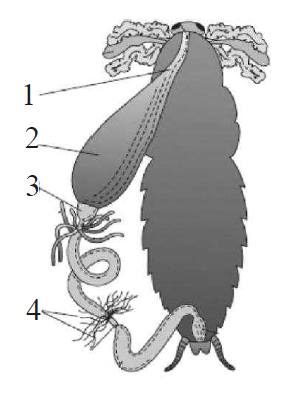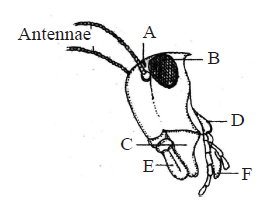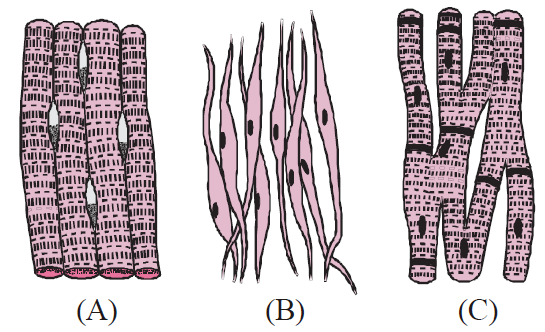Which of the following type of muscle tissue is being described on the basis of given statements ?
- These muscle fibres taper at both ends and do not show striations.
- The wall of internal organs such as the blood vessels, stomach and intestine contain this type of muscle tissue.
- They are involuntary as their function cannot be directly controlled.
Skeletal muscle
Smooth muscle
Cardiac muscle
All of these
Correct Answer :
B. Smooth muscle
The smooth muscle fibres are involuntary, taper at both ends and do not show striation. The wall of internal organs such as the blood vessels, stomach and intestine contains this type of muscle tissue.
Related Questions
Statement 1 : Intercalated discs are important regions of cardiac muscle cells.
Statement 2 : Intercalated discs function as boosters for muscle contraction waves.
Statement-1 and statement-2 are true and statement-2 is a correct explanation for statement-1.
Statement-1 and statement-2 are true and ttatement-2 is not a correct explanation for statement-1
Statement-1 is true, and statement-2 is False
Both the statements are false.
Lack of blood supply and presence of the noncellular basement membrane are the characteristics of the
muscular tissue
fluid connective tissue
epithelial tissue
nervous tissue
A student was given a specimen to identify on the basis of the characteristics given below.
- They are metamerically segmented.
- Presence of closed circulatory system.
- They have circular and longitudinal muscles for locomotion.
Identify the specimen.
Frog
Pheretima
Cockroach
Rabbit
In the given diagram of areolar connective tissue, the different cells and parts have been marked by alphabets (A, B, C & D). Choose the answer in which these alphabets correctly match with the parts and cells they indicate.

A-Adipocyte, B-Collagen fibres, C-Microfilament, D-Mast cells
A-Macrophage, B-Collagen fibres, C-Microfilament, D-Mast cells
A-Macrophage, B-Collagen fibres, C-Microtubule, D-RBC
A-Macrophage, B-Fibroblast, C-Collagen fibres, D-Mast cells
The figure given below shows the alimentary canal of cockroach with few structures labelled as 1, 2, 3 and 4. Identify the correct identification of the structure which is also called proventriculus and helps in grinding the food particles.

1
2
3
4
The given figure shows open circulatory system of cockroach with structure marked as A, B and C. Which structure is a 13 pair of wing shaped involuntary muscles and mantain blood circulation?

A
B
C
Both A nad B
Male cockroach can be identified from the female by the presence of
long antennae
wingless body
elongated abdomen
anal styles
Smooth muscles are______.
voluntary, branched, uninucleate
voluntary, multinucleate, cylindrical
involuntary, cylindrical, multinucleate
involuntary, spindle shaped, uninucleated, tapering
The given figure shows the digestive system of cockroach with few structures marked as A, B, C and D. Identify structures A to D.

A-Gizzard, B-Crop, C-Hepatic caecae, D-Malpighian tubules
A-Crop, B-Gizzard, C-Hepatic caecae, D-Malpighian tubules
A- Crop, B-Gizzard, C-Malpighian tubules, D-Hepatic caecae
A- Gizzard, B-Crop, C-Malpighian tubules, D-Hepatic caecae
Match the terms given in column-I with their feature given in column-II and choose the correct option.
| Column-I | Column-II |
|---|---|
| (Terms) | (Features) |
| A. Exocrine gland | I. They help to stop substances from leaking across a tissue |
| B. Endocrine gland | II. Hormones are secreted directly into the fluid bathing the gland |
| C. Tight junctions | III. They perform cementing to keep neighbouring cells together. |
| D. Adhering junctions | IV. Secretes mucus, saliva, earwax, oil, milk, digestive enzymes and other cell products |
A IV; B II; C I; D III
A II; B IV; C I; D III
A IV; B II; C III; D I
A IV; B I; C II; D III
Phallic organs in cockroach are related to
male excretory system.
male reproductive system.
female excretory system.
female reproductive system.
Read the following statements.
- It is a contractile tissue present only in the heart.
- Cell junctions fuse the plasma membranes of these cells and make them stick together.
- Communication juntions at some fusion points allow the cells to contract as a unit, i.e., when one cell receives a signal to contract, its neighbours are also stimulated to contract.
Which of the following type of tissue is being described by the above statements ?
Skeletal muscle
Cardiac muscle
Smooth muscle
Cartilage
The figure given below shows the head region of cockroach. Identify A to F.

A- Compound eye, B-Ocellus, C-Maxilla, D-Mandible, E-Labrum, F-Labium
A- Ocellus, B-Compound eye, C-Mandible, D-Maxilla, E-Labrum, F-Labium
A- Ocellus, B-Compound eye, C-Mandible, D-Maxilla, E-Labium, F-Labrum
A- Ocellus, B-Compound eye, C-Maxilla, D-Mandible, E-Labrum, F-Labium
Which of the following statement (s) is/are correct ?
- Loose connective tissue contains fibroblasts, macrophages and mast cells.
- Adipose tissue is a type of dense connective tissue located mainly beneath the skin.
- Tendons and ligaments are examples of dense irregular connective tissue.
- Cartilage, bones and blood are various types of specialized connective tissue.
Only (i)
Both (ii) and (iv)
Both (i) and (iii)
(i), (iii) and (iv)
Which of the following types of connective tissue is mismatched with its matrix ?
Areolar Loosely packed matrix of protein fibres
Bone Mineralized matrix
Cartilage Highly vascular matrix
Blood Liquid matrix
What will happen if ligaments are cut or broken?
No movements at joints.
Bones will become fixed.
Bones will become unfixed.
Bone will move freely at joints.
General function of gland is to
protect the body.
control the function of epithelial tissues.
produce and secrete specialized compounds to control and maintain different body functions.
help to maintain blood pressure and nerve actions.
Which of the following statement is/are correct regarding digestive system of cockroach ?
- Mouth opens into a short tubular pharynx, leading to a narrow tubular passage called oesophagus.
- Gizzard helps in grinding the food particles.
- A ring of 6-8 blind tubules called hepatic or gastric caecae is present at the junction of foregut and midgut, which secrete digestive juice.
- At the junction of midgut and hindgut is present another ring of 100-150 yellow coloured thin filamentous malphigian tubules which help in removal of excretory products from haemolymph.
Only (i)
Both (ii) and (iii)
Both (i) and (iv)
All of these
The following figures A, B and C are types of muscle tissue. Identify A, B and C.

A Smooth muscle, B Cardiac muscle, C Skeletal muscle
A Skeletal muscle, B Smooth muscle, C Cardiac muscle
A Cardiac muscle, B Smooth muscle, C Skeletal muscle
A Smooth muscle, B Skeletal muscle , C Cardiac muscle
When cardiac muscle cells are damaged by a heart attack, they are usually replaced by
connective tissue cells
new smooth muscle cells
new cardiac muscle cells
epithelial cells
Cartilage tissues are likely to be slow in healing following an injury because
cartilage cells cannot reproduce.
they lack direct blood supplies.
the intercellular material is missing.
cartilage cells are surrounded by fluids.
The only type of cell seen in a tendon is
muscle fibres
reticular cells
collagenous cells
fibroblasts
The chondrocytes of connective tissue are
fibre secreting cells
bone forming cells
cartilage cells
bone eating cells
What are the three basic components of connective tissues?
Ground substance, cells and basement membrane
Cartilage, intercellular matrix and serum
Cells, protein fibers and ground substance
Collagen, elastin and reticular fibers
The kind of epithelium which forms the inner walls of blood vessels is
cuboidal epithelium
columnar epithelium
ciliated columnar epithelium
squamous epithelium
What external changes are visible after the last moult of a cockroach nymph?
Development of anal cerci.
Development of both forewings and hind wings.
Development labium.
Mandibles become harder.
Which of the following vertebrate tissues would be an excellent source of collagen?
Liver
Nerve
Muscle
Tendon
The secretions of endocrine glands are released directly
into the skin surface
into the blood stream
into a gland duct
into the brain tissue
Which of the following statements regarding frog is not correct?
Fertilization is external and takes place in water.
External ear and tympanum can be seen externally.
In females the ureters and oviduct open separately in the cloaca.
Copulatory pad on the first digit of the fore limbs and vocal sac are present in male frog.
Which one of the following pairs of structures distinguishes a nerve cell from other types of cell ?
Vacuoles and Fibres
Flagellum and Medullary sheath
Nucleus and Mitochondria
Cell body and Dendrites
